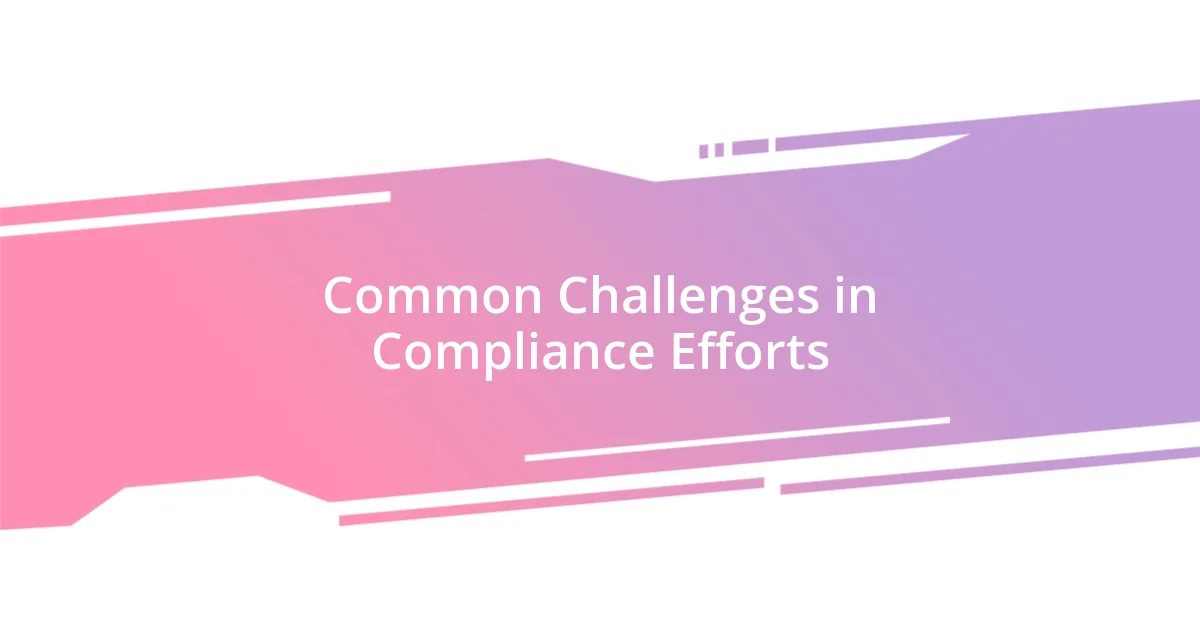Key takeaways:
- Effective compliance requires alignment between company culture and regulatory requirements, and fostering a culture of transparency enhances engagement.
- Tailored compliance strategies, including customized training and active employee involvement, promote ownership and a proactive compliance environment.
- Continuous improvement through feedback, technology integration, and regular evaluations transforms compliance from a chore into a collaborative and evolving process.

Understanding Compliance Strategies
Compliance strategies are frameworks that help organizations adhere to laws, regulations, and internal policies. I remember when I first navigated this landscape; it felt overwhelming at times. Does it ever seem like compliance is just a mountain of paperwork? Well, it doesn’t have to be.
At its core, understanding compliance strategies means recognizing the importance of alignment between company culture and regulatory requirements. I once worked with a team where compliance was seen as a burden rather than an integral part of our operations, and it really affected morale. What if we viewed compliance as a way to enhance our credibility and foster trust with clients?
Moreover, successful compliance requires continuous education and open communication across all levels of an organization. I’ve seen firsthand how a culture of transparency can bring compliance principles to life, making them not just rules to follow but a shared mission. Could adopting this approach turn your compliance efforts from a chore into a collaborative success story?

Importance of Tailored Approaches
Tailoring compliance strategies is essential because one-size-fits-all solutions often miss the unique needs of an organization. I recall a time when our generic compliance training session failed to resonate with my team, leaving them confused and disengaged. It wasn’t until we customized our training to reflect our specific challenges and industry nuances that we started to see real engagement and understanding.
Another aspect to consider is that tailored approaches can significantly enhance compliance culture. In one organization I worked with, we conducted a thorough assessment of all departmental functions and aligned our compliance protocols accordingly. This not only streamlined our processes but also fostered a sense of ownership among employees, making them champions of compliance rather than mere participants.
Ultimately, embracing tailored compliance strategies creates a proactive environment where employees feel empowered to contribute. I remember when we invited feedback from various teams to shape our compliance initiatives—it transformed compliance into a collective effort. When everyone knows their input matters, the culture shifts from compliance as a task to compliance as a shared goal.
| Standard Approach | Tailored Approach |
|---|---|
| Generalized training | Customized training sessions |
| Uniform policies | Role-specific guidelines |
| Passive compliance culture | Active employee involvement |

Key Components of Effective Compliance
Effective compliance hinges on several key components that must be interwoven into the fabric of an organization. I’ve learned that leadership engagement is critical; when executives actively support compliance initiatives, it sends a powerful message to the entire team. In a previous role, I remember a senior manager stepping up during our compliance training—sharing his own challenges and victories. That simple act of vulnerability made compliance feel less intimidating for everyone, transforming it from an abstract concept into something relatable and actionable.
Building a robust training program is another essential component. Imagine my surprise when I discovered that a workshop I thought would be a snooze fest turned into a lively discussion. Employees felt safe to share their experiences, turning compliance talk into a real-world dialogue. This kind of interaction not only dispels the “them vs. us” mentality but also encourages a deeper understanding of compliance roles.
Key components of effective compliance include:
- Leadership Engagement: Leaders who model compliance behavior inspire others to follow suit.
- Robust Training Programs: Interactive training fosters meaningful conversations about compliance.
- Clear Communication: Guidelines should be articulated in straightforward language.
- Ongoing Monitoring: Regular assessments help to identify areas for improvement and maintain compliance standards.
By weaving these elements together, organizations can foster an environment where compliance thrives and isn’t viewed as an obstacle. Personal stories can illuminate these components, making the principles feel less daunting and more like integral parts of a cohesive strategy.

Tools for Successful Compliance Implementation
Having the right tools can hugely impact how compliance is implemented within an organization. From my experience, compliance management software is one of the most effective tools we’ve adopted. Initially, I was skeptical about whether it could truly simplify our processes. However, after some time, seeing everything from training schedules to reporting capabilities under one umbrella made compliance feel much more manageable. It doesn’t just keep us organized; it also provides invaluable insights that help to proactively address potential issues.
Communication tools are another essential aspect. During a complex compliance initiative, we began using a dedicated messaging platform to encourage open dialogue among team members. Honestly, I was amazed at how quickly questions were answered and concerns were addressed. This real-time communication helped the entire team feel more connected and informed, transforming compliance from a solitary endeavor into a collaborative effort. Have you considered how your team communicates about compliance? It truly makes a difference.
Lastly, I’ve found that feedback mechanisms such as surveys or suggestion boxes bring to light areas for improvement that we might not have seen otherwise. After implementing an anonymous survey following our compliance initiatives, I was struck by the candidness of the responses. Some suggestions were simple yet incredibly effective. This feedback loop not only helps refine our strategies but also empowers employees, letting them know their voices are heard and valued in the compliance process. So, how are you collecting feedback from your team? Are you ready to embrace this powerful tool?

Common Challenges in Compliance Efforts
Common challenges in compliance efforts can often originate from a lack of clear communication. I recall a time when our team faced confusion about specific regulatory guidelines. Misunderstandings flew left and right, and it dawned on me that without straightforward language from the leadership, compliance can seem like reading a foreign language. Have you ever experienced a similar breakdown in communication? It’s a tough obstacle that can lead to significant compliance gaps.
Another issue arises when organizations underestimate the importance of employee engagement. During one compliance initiative, I saw firsthand how resistance could easily bubble up. Many team members viewed compliance as a chore rather than a crucial aspect of our work culture. It made me wonder, how can we transform this perception? I’ve learned that bringing employees into the conversation—from sharing their stories to discussing the importance of compliance—can enhance their buy-in. When employees feel involved, compliance takes on a whole new significance.
Finally, scalability can be a daunting challenge as organizations grow. I experienced this firsthand when we expanded my previous workplace and subsequently tangled with new compliance requirements. At that moment, we had to find ways to adjust our strategies, which felt overwhelming. I often ask, how can we ensure that our compliance efforts evolve as we do? A flexible approach, one that adapts to new circumstances while retaining core principles, can help mitigate this challenge.

Measuring Compliance Success Criteria
Measuring compliance success criteria is a crucial step that can often be overlooked. From my own experience, I’ve found that setting clear, quantifiable metrics right from the start significantly clarifies what we’re aiming to achieve. For instance, when we implemented a new training program, tracking completion rates and subsequent assessments revealed not only how well employees engaged but also highlighted areas that needed improvement. Did you know that these simple metrics can provide deeper insights into employee readiness and overall compliance culture?
One of the most enlightening moments for me occurred when we began to evaluate compliance not just through numbers but through employee sentiment. After we launched a compliance initiative, we conducted focus groups to gather qualitative feedback. It was eye-opening to hear employees express their thoughts on the training’s effectiveness and its relevance to their daily tasks. Have you ever wished you could step into your team’s shoes? Feeling their perspectives allowed us to refine our strategies, making compliance more relatable and practical for everyone involved.
Lastly, I believe in the importance of continuous improvement in compliance measurement. I remember a time when we analyzed past compliance events and their resolution times. Initially, I thought these figures were merely statistics, but the trends we noticed highlighted systemic issues we hadn’t tackled. By setting up a cycle of regular reviews and adjustments based on these insights, compliance became a journey rather than a destination. How often are you reassessing your compliance strategies? This ongoing evaluation can transform both individual and organizational practices, creating a robust compliance framework.

Continuous Improvement in Compliance Practices
When it comes to continuous improvement in compliance practices, I’ve found that fostering a culture of feedback is essential. I remember a project where we encouraged team members to share their compliance-related challenges openly. It wasn’t just about identifying issues—we created a safe space for sharing successes, too. This approach not only illuminated blind spots but also sparked innovative solutions. Have you ever noticed that when people feel heard, their motivation to improve increases?
One pivotal moment for me was during a compliance audit where we implemented a post-audit review process. Instead of just ticking boxes, we gathered insights from the team on what worked and what didn’t. I was pleasantly surprised by the wealth of suggestions that emerged! It reminded me of how invaluable it is to involve team members in refining compliance practices. What if we saw audits as an opportunity for growth, rather than a mere obligation? This shift in perspective can make all the difference.
Moreover, I believe that leveraging technology plays a significant role in continuous improvement. In one instance, our team adopted compliance management software that automated tracking and reporting. The time we saved allowed us to focus on strategic discussions around compliance enhancements. I often ask myself, how can we integrate technological tools that simplify processes and elevate compliance efforts? Embracing these advancements not only boosts efficiency but can lead to a more proactive compliance culture.














